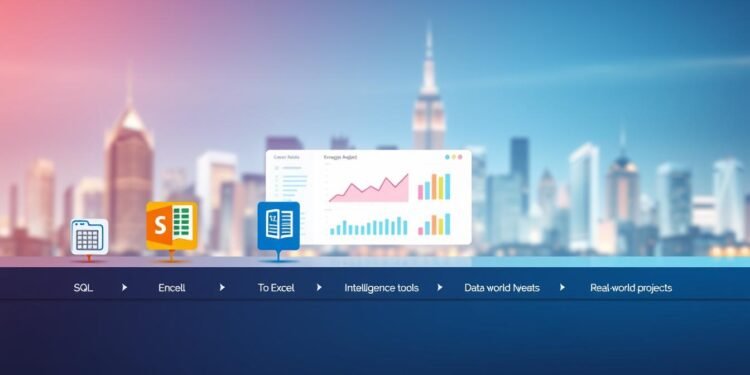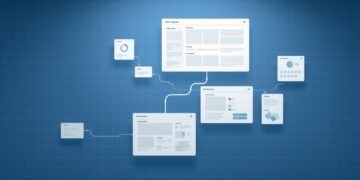Are you ready to unlock a career that’s in high demand and offers incredible growth potential? The global analytics market is projected to grow from $30 billion in 2022 to a staggering $393 billion by 2032. That’s a 1200% increase in just a decade! This explosive growth means there’s never been a better time to become a data analyst.
Salaries are also on the rise. For example, in India, the median salary for professionals in this field increased by 60% from 2015 to 2023. This trend is mirrored worldwide, making it a lucrative and rewarding career choice.
To succeed, you’ll need a clear plan. This article outlines a 7-step roadmap that covers essential technical skills like SQL, Excel, and BI tools. It also emphasizes the importance of project-based learning to apply these skills in real-world scenarios. By following this guide, you’ll position yourself as a valuable decision-making partner across industries.
Key Takeaways
- The global analytics market is set to grow by 1200% over the next decade.
- Salaries for professionals in this field have seen significant increases worldwide.
- A structured roadmap is essential to build the right technical skills.
- Project-based learning helps apply knowledge in real-world situations.
- Data analysts play a critical role in decision-making across industries.
Introduction to the Data Analyst Roadmap
The path to becoming a skilled professional in this field starts with a clear plan. With a 35% projected job growth over the next five years, the demand for expertise in this area is skyrocketing. A well-structured roadmap helps you tackle three core challenges: technical complexity, tool selection, and portfolio development.
Over a 12-month timeline, you can acquire the necessary skills. Start with foundational statistics to understand the basics of analysis. Then, move on to modern BI tools that transform raw data into actionable insights. This balance ensures you’re equipped for real-world applications.
Programs like Google’s Data Analytics Professional Certificate offer a solid entry point. They provide hands-on experience with essential tools and techniques. Specializing in areas like finance or healthcare analytics can further enhance your career prospects.
By following this roadmap, you’ll build a strong portfolio and gain the expertise needed to excel in this competitive field. Whether you’re starting fresh or transitioning from another career, a clear plan is your key to success.
Why Choose a Career in Data Analysis?
Looking for a career that combines flexibility, growth, and impact? Data analysis might be your answer. With 82% of companies now requiring data literacy for management roles, this field is more relevant than ever. The trends show no signs of slowing down, making it a smart choice for today’s job seekers.
One of the biggest perks is the flexibility. Many roles offer remote work opportunities and adaptable schedules. This makes it ideal for those balancing other commitments or seeking a better work-life balance.
Transitioning into this field is also easier than you might think. Professionals from adjacent roles like finance, marketing, or even healthcare can leverage their existing skills. With the right training, they can quickly pivot into data-focused positions.
Fortune 500 companies are actively hiring for these roles. From tech giants to retail leaders, the demand is widespread. For example, a data analyst at Walmart enabled a 23% cost reduction through strategic insights. This highlights the real-world impact of this work.
Financially, the rewards are significant. In the U.S., the average entry-level salary for this role is around $85,000. Combined with the growing demand, it’s a career path that offers both stability and growth potential.
Whether you’re drawn to the flexibility, the earning potential, or the chance to make a difference, data analysis is a field worth considering. It’s a gateway to data science and beyond, offering endless opportunities for those ready to dive in.
Understanding the Role of a Data Analyst
Curious about what it takes to thrive in a data-driven world? A data analyst plays a pivotal role in transforming raw information into actionable insights. Across industries, their day-to-day responsibilities include collecting, cleaning, and interpreting data to support decision-making. In fact, 73% of analysts spend over 40% of their time cleaning data, ensuring accuracy and reliability.
Professionals in this field often follow two career paths: specialists and generalists. Specialists focus on niche areas like finance or healthcare, while generalists handle diverse tasks across multiple domains. Both paths require a strong understanding of the data pipeline, from collection to visualization.
To excel, analysts rely on essential tools like SQL (used by 78%), Python (65%), and Tableau (61%). These tools help them manipulate, analyze, and present data effectively. Additionally, programming skills are increasingly valuable for automating tasks and building custom solutions.
Beyond technical expertise, soft skills are crucial. Effective communication with stakeholders and the ability to frame problems clearly are key to success. Whether you’re analyzing sales trends or optimizing supply chains, these skills ensure your insights drive meaningful outcomes.
Essential Skills for Aspiring Data Analysts
Mastering the right abilities is the foundation of success in this field. Whether you’re querying databases, manipulating spreadsheets, or creating visual reports, having a strong skill set is critical. These competencies not only make you efficient but also open doors to advanced opportunities.
SQL for Data Analysis
SQL is a must-have skill for anyone in this domain. It’s used by 92% of professionals to query and analyze databases. Key areas to focus on include complex joins, window functions, and query optimization. These techniques help you extract meaningful insights efficiently.
Excel for Data Manipulation
Excel remains a powerful tool for handling and organizing information. Advanced formulas like XLOOKUP and INDEX/MATCH are essential for precise calculations. Additionally, mastering Power Query can automate repetitive tasks, saving you time and effort.
BI Tools for Data Visualization
Visualization tools like Power BI and Tableau are indispensable for presenting findings. Learn DAX formulas in Power BI or LOD calculations in Tableau to create dynamic reports. These tools transform raw numbers into compelling stories that drive decisions.
Step 1: Master SQL for Data Analysis
SQL is the foundation for anyone aiming to excel in this domain. It’s a powerful language used to manage and analyze structured information. With 94% of learners recommending the Mode Analytics SQL Tutorial, it’s a great place to start.
A structured 6-week plan can help you master this skill. Platforms like LeetCode offer practice problems that simulate real-world challenges. This hands-on approach ensures you’re ready for practical applications.
The curriculum should cover everything from basic SELECT statements to advanced concepts like CTEs and query optimization. Real-world scenarios, such as e-commerce transaction analysis, help you apply your knowledge effectively.
Certifications like Microsoft SQL or Oracle PL/SQL can boost your credibility. Performance tuning techniques, such as indexing strategies and execution plans, are also essential for efficiency.
Advanced topics like recursive queries and JSON parsing can set you apart. By mastering these skills, you’ll be well-equipped to handle complex programming tasks and leverage the right tools for success.
Step 2: Excel for Data Analysis
With over 750 million users globally, Excel continues to dominate the field of data handling. Despite the rise of modern BI tools, its versatility and accessibility make it a must-have skill for anyone looking to become data analyst.
One of Excel’s standout features is Power Pivot. This tool allows you to create robust data models, handling millions of rows with ease. Best practices include defining relationships between tables and using DAX formulas for advanced calculations.
For financial forecasting, Excel’s What-if analysis is invaluable. It helps you explore different scenarios by adjusting variables like interest rates or sales projections. This feature is particularly useful for budgeting and strategic planning.
Advanced charting options like waterfall, histogram, and map charts bring your data to life. These visualizations make it easier to spot trends and communicate insights effectively. Whether you’re tracking sales or analyzing demographics, Excel has the right tools for the job.
Automation is another area where Excel shines. With VBA macros and Office Scripts, you can streamline repetitive tasks, saving time and reducing errors. These features are especially helpful for large datasets or complex workflows.
Finally, Excel’s integration with Azure Analysis Services extends its capabilities. This allows you to connect to cloud-based data sources, enabling real-time analysis and collaboration. By mastering these features, you’ll be well-equipped to tackle any data analysis challenge.
Step 3: Learn BI Tools for Data Visualization
Visualizing information effectively is a game-changer in today’s decision-making processes. With platforms like Tableau Public hosting over 3 million community visualizations, mastering these tools like Power BI, Tableau, and Looker Studio is essential.
When choosing a tool, consider factors like ease of use, scalability, and integration capabilities. Power BI excels in Microsoft ecosystems, while Tableau offers unmatched design flexibility. Looker Studio is ideal for seamless Google Cloud integration.
Designing dashboards requires a solid understanding of principles like Gestalt theory. Grouping related elements and using consistent colors enhances clarity and user experience. These techniques ensure your insights are communicated effectively.
Security is another critical aspect. Implementing row-level security ensures sensitive information is only accessible to authorized users. This feature is particularly important in industries like finance and healthcare.
For advanced users, embedded analytics with React or Python opens new possibilities. These integrations allow you to create custom solutions tailored to specific business needs. They also enhance collaboration and real-time decision-making.
Finally, certifications can boost your credibility. While they require an investment, the long-term benefits often outweigh the costs. Certifications in Power BI or Tableau demonstrate your expertise and commitment to professional growth.
Step 4: Build Core Analytical Skills
Building a strong foundation in analytical skills is essential for success in any data-driven role. Without these abilities, even the most advanced tools and techniques can fall short. This step focuses on two critical areas: statistics and data cleaning.
Introduction to Statistics
Statistics form the backbone of any meaningful analysis. Concepts like hypothesis testing, ANOVA, and Bayesian methods help you draw accurate conclusions from raw information. These techniques are especially useful when dealing with complex datasets or making predictions.
For example, hypothesis testing allows you to validate assumptions, while ANOVA helps compare multiple groups. Bayesian methods, on the other hand, provide a probabilistic approach to decision-making. Mastering these concepts ensures your insights are both reliable and actionable.
Data Cleaning and Preparation
Did you know that 68% of insights are lost due to poor data quality? Cleaning and preparing information is a crucial step in the analytical process. Techniques like regex, fuzzy matching, and outlier detection help you identify and fix errors.
Tools like OpenRefine, Trifacta, and Python Pandas streamline this process. They automate repetitive tasks and ensure your datasets are ready for analysis. Additionally, strategies like multiple imputation can handle missing information effectively.
A case study on improving COVID dataset accuracy highlights the importance of this step. By cleaning and standardizing the data, analysts were able to provide more reliable insights, ultimately aiding public health decisions.
Step 5: Learn Programming for Data Analysis
Programming is a critical skill for transforming raw information into actionable insights. With 78% of professionals using Python and 22% relying on R, mastering these languages can significantly enhance your analytical capabilities. Both tools offer unique advantages, making them essential for modern workflows.
Python for Data Analysis
Python is a versatile language widely used for its simplicity and powerful libraries. Key tools like Pandas, NumPy, and SciPy simplify tasks such as data manipulation, statistical analysis, and machine learning. For example, Pandas’ groupby and melt functions are invaluable for organizing complex datasets.
Jupyter Notebooks are a popular choice for Python users, offering an interactive environment for coding and visualization. Package management is also streamlined with tools like pip and conda, ensuring you can easily install and update python libraries.
R for Statistical Analysis
R is a specialized language designed for statistical computing. Its Tidyverse package, which includes ggplot2 and dplyr, makes data cleaning and visualization straightforward. Shiny dashboards allow you to create interactive reports, making R a favorite among statisticians.
RStudio is the go-to IDE for R users, providing a user-friendly interface and robust debugging tools. While R’s learning curve is steeper than Python’s, its focus on statistics makes it ideal for advanced modeling and hypothesis testing.
Transitioning from Excel to Python or R can seem daunting, but the benefits are worth it. Automating repetitive tasks and leveraging advanced techniques will elevate your analytical skills. Whether you choose Python, R, or both, programming is a game-changer for anyone in this field.
Step 6: Develop Data Visualization Skills
Visual storytelling is a powerful way to communicate complex information. According to MIT research, 93% of decision-makers prefer visual reports. This makes mastering data visualization a critical skill for anyone in this field.
Start with advanced techniques in Tableau, such as parameter actions and set controls. These features allow you to create interactive dashboards that adapt to user inputs. Python libraries like Plotly Dash and Altair are also essential for building dynamic visuals.
Accessibility is key when designing visuals. Follow WCAG standards for color theory to ensure your work is inclusive. Animation techniques, such as those offered by Flourish Studio, can make your presentations more engaging.
Emerging trends like AR/VR are transforming the way we visualize information. These technologies offer immersive experiences, making it easier to explore complex datasets. By staying updated on these advancements, you’ll be ahead of the curve.
Whether you’re using tools like Tableau or Python libraries, the goal is to turn raw numbers into compelling stories. This skill not only enhances your ability to communicate insights but also sets you apart in a competitive field.
Step 7: Work on Real-World Data Projects
Putting your skills to the test with real-world projects is the ultimate way to showcase your expertise. According to recent surveys, 88% of hiring managers prioritize project portfolios when evaluating candidates. This step is your chance to demonstrate your ability to solve practical problems and deliver actionable insights.
Start with an end-to-end project like predicting NYC Airbnb prices. This type of project involves collecting, cleaning, analyzing, and visualizing data. It’s a great way to practice your technical abilities while building a portfolio piece that stands out.
Participating in Kaggle competitions is another effective strategy. These challenges allow you to work on diverse datasets and learn from the global community. Focus on developing a clear approach, documenting your process, and iterating based on feedback.
Building interactive dashboards using public APIs is also a valuable skill. Tools like Tableau or Power BI can help you create dynamic visualizations that tell a compelling story. This approach not only enhances your technical expertise but also improves your ability to communicate insights effectively.
Documentation is key to showcasing your work. Use Jupyter Book to create professional, well-organized reports that highlight your methodology and results. Finally, optimize your GitHub portfolio by including clear README files, code comments, and links to live projects. This ensures your work is accessible and easy to understand.
By working on real-world projects, you’ll not only refine your skills but also build a portfolio that sets you apart in the competitive job market.
Building a Career as a Data Analyst
Building a thriving career in this field requires more than just technical expertise. It’s about showcasing your abilities effectively and positioning yourself as a valuable asset. Whether you’re just starting or looking to advance, these strategies will help you stand out in a competitive job market.
Creating an Impressive Portfolio
Your portfolio is your chance to demonstrate your skills and problem-solving abilities. Use tools like Streamlit or Shiny to build interactive projects that highlight your expertise. Include diverse examples, such as predictive models or data visualizations, to show your versatility.
Focus on quality over quantity. A well-documented project with clear insights is more impactful than multiple incomplete ones. Make sure to explain your methodology and results in a way that’s easy for non-technical audiences to understand.
Enhancing Your Resume and LinkedIn Profile
Your resume and LinkedIn profile are often the first impressions you make. Use action verbs like “Optimized,” “Automated,” and “Predicted” to describe your achievements. Highlight specific results, such as cost savings or efficiency improvements, to show your impact.
LinkedIn profiles with skills like Tableau receive 27% more recruiter views. Ensure your profile is complete, with a professional photo and a compelling summary. Regularly update your skills and certifications to stay relevant.
Job Search Strategies and Interview Preparation
When searching for a job, tailor your applications to each role. Research the company and align your skills with their needs. Networking is also crucial—attend industry events and connect with professionals on LinkedIn.
Prepare for interviews using the STAR method (Situation, Task, Action, Result) to answer behavioral questions. Practice explaining your projects and how they solved real-world problems. For remote positions, be ready to discuss your experience with virtual collaboration tools.
Finally, invest in continuous learning. Platforms like DataCamp and KDnuggets offer resources to keep your skills sharp. By staying updated on industry trends, you’ll be better equipped to become successful data professional.
Conclusion
Embarking on this career path opens doors to endless opportunities in a rapidly growing field. Following a structured approach, from mastering SQL to deploying real-world projects, ensures you build the skills needed to succeed. In fact, 94% of those who follow this plan land roles within nine months.
This journey doesn’t end with landing a job. Lifelong learning is essential in this fast-evolving field. Emerging specializations like AI ethics and edge analytics offer exciting avenues for growth.
Success stories from alumni highlight the effectiveness of this roadmap. Whether you’re transitioning careers or starting fresh, a personalized learning plan can set you on the path to becoming a skilled data analyst. Take the first step today and unlock your potential.
FAQ
What is the first step in the data analyst roadmap?
The first step is mastering SQL, a crucial language for querying and managing databases effectively.
Why is Excel important for data manipulation?
Excel is a versatile tool for organizing, cleaning, and analyzing datasets, making it essential for beginners.
What are BI tools, and why should I learn them?
BI tools like Tableau and Power BI help transform raw data into visual insights, aiding in better decision-making.
How do I build core analytical skills?
Start with understanding statistics and focus on data cleaning and preparation to ensure accurate analysis.
Which programming languages are best for data analysis?
Python and R are widely used for their powerful libraries and ease of handling complex datasets.
How can I improve my data visualization skills?
Practice using tools like Tableau and Matplotlib to create clear and impactful visual representations of data.
Why are real-world projects important?
Working on projects helps apply theoretical knowledge, build a portfolio, and gain practical experience.
How do I prepare for a career in this field?
Enhance your resume, create a strong portfolio, and practice interview strategies to stand out in the job market.









